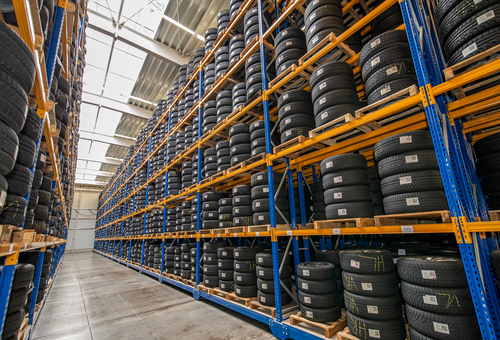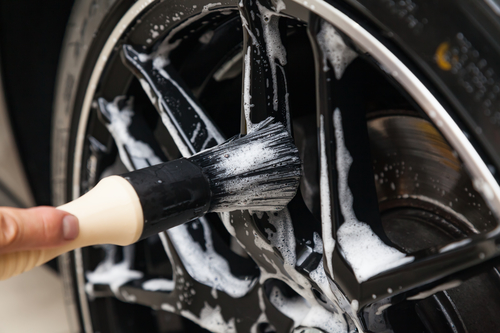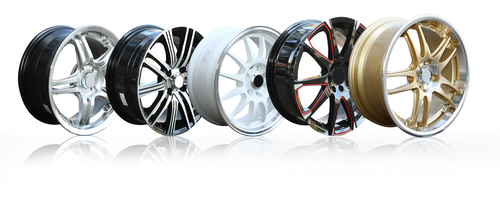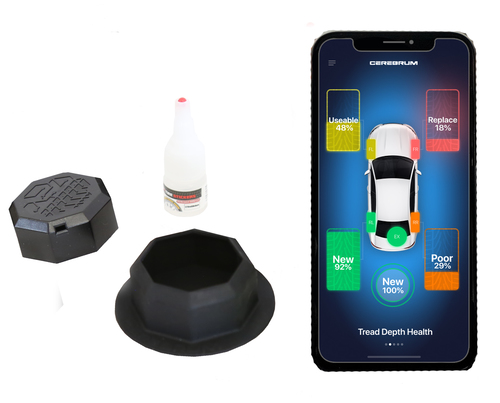BUSINESS
Wheel and Tire Market Trends
Have Global Disruptions Slowed Momentum?

supply-chain and related market disruptions to the global tire industry
in 2020, with the repercussions likely to be felt for several years to
come.
Wheels and tires are more than essential vehicle components—they’re performance and style enhancers. Whether for street, track or trail, they’re among the easiest and most purposeful modifications an automotive enthusiast can undertake. With the right wheel-and-tire combo able to make all the difference for handling, confidence and ride enjoyment, it’s no wonder they have remained stalwart sellers for the aftermarket.
In fact, performance and special-purpose tires represent the largest sales category within the specialty-equipment tire market, according to the recently released “2020 SEMA Market Report.” From 2016 to 2019, the category’s market size grew from $2.22 billion to $2.54 billion. Of the application types in that total, midrange cars and pickups each took market shares of 19%, followed closely by sports cars (16%), SUVs (14%) and CUVs (11%).
Next to the performance category, off-road and plus-size tires are also strong performers, comprising a market total of $1.88 billion in 2019, up from $1.62 billion just three years prior. Pickup applications took the lion’s share of sales in that category, accounting for a massive 69% of purchasing. SUV applications followed at 22%.
Of course, tires are useless without wheels, and custom wheels as a category grew steadily in market size from a $1.21 billion valuation in 2016 to $1.32 billion in 2019. Again, pickup applications dominated in that category, comprising 40% of sales. Midrange vehicles followed at 10%, and SUVs at 13%. Although CUVs represent an increasingly popular vehicle category, their tire sales amounted to a mere 8% of market share.

wrong ones can wreak havoc. The SEMA Wheel & Tire Council
continues to make its “Wheel Care Guide” available for use in internal
staff training or as a counter-topper for customers.
Whatever the wheel or tire category, however, the storyline for the aftermarket over the past few years has been one of upward growth, with every expectation that the trajectory would continue well into 2021. But that was all before COVID-19.
According to Janine Young, a commissioning editor at Smithers Information, COVID-19 has dealt a series of critical disruptions to the global tire industry.
“The pandemic affected the global economy, collapsing vehicle and equipment production sales and usage as well as tire production and trade,” she said, adding that a recent Smithers market report, “The Future of Global Tires to 2024,” identified the following trends as likely to impact the industry for some time to come:
- The industry is experiencing its largest volume declines in decades, and conditions have been characterized as “exceptionally soft.”
- Recovery is expected to be slow, with lagging global resolution to the virus.
- The weakened economy, lack of consumer confidence and high global unemployment rates have resulted in a plunge in auto sales and aftermarket tire sales.
- In the supply chain, consumption of tire materials has dropped in line with tire manufacturing, creating declining prices for natural and synthetic rubber and other key commodities.
- R&D budgets and investments in new technologies are being curtailed to shore up other critical business functions.
- Changing consumer patterns, such as working from home and e-commerce, are likely to have a lasting effect on tire industry practices.
- Industry production levels will be impacted for the long-term, with implications for global supply chains.
“In general, replacement-tire demand will remain muted during the recovery,” Young said. “Passenger car, SUV and noncommercial light-truck vehicles and tires saw a slight bounce over the summer but will likely take three-plus years to again reach 2019 demand. Passenger-car, light-truck and medium- to heavy-duty trucks are most impacted by commercial and personal traffic reductions.”

shortages and significant backorders for a variety of wheel products.
In 2021, look for colored wheels—and especially those with black
satin and sheen finishes—to remain popular alternatives over
polished chrome for consumers.
Related Smithers research also now forecasts a slump in the prestige, luxury and high-performance passenger-tire categories as well.
“Tire segments that are more resilient are commercial van tires, due to the tremendous growth in last-mile delivery for e-commerce shopping, and motorcycle tires, due to their shorter replacement cycle,” Young explained. “A lowering of consumer purchasing power and transportation needs will favor motorcycles at the expense of entry-level car purchases in some areas, although less commuting will overall damage replacement-tire demand.”
How that will play out in the domestic wheel and tire aftermarket remains to be seen. As of fall 2020, many SEMA-
member companies reported stable sales after an initial spring 2020 dip.
SEMA Wheel & Tire Council (WTC) select committee member Ted Schlaack is a business consultant for RimTyme, a franchised network of sales and rental custom wheel and tire stores that is entering 2021 in relatively good shape. Schlaack believes that tire sales have been helped by improvements at every level of product, making lower-priced lines more attractive to consumers.
Atturo is another—they’re sales are holding up as well as a Nitto, Toyo or BFG. Everyone wants a big brand, but they don’t necessarily want the big price. We’re seeing better quality out of off-name brand products, helping get sales or rentals with a lower price. Of course, the big companies have always done a great job, and their tires are lasting as long as they have in the past.”

the wheel and tire aftermarket. Inserted into tires, the smart sensors
transmit a broad range of tire data to the consumer’s smartphone—
well beyond the basic information supplied by TPMS.
On the Wheel Side
Meanwhile, the wheel market now appears to be recovering after also taking a hit in spring 2020.
“In February, March and April, we lost a lot of business, then it roared back, and by October we were exceeding 2019 results and having a banner year in 2020,” Schlaack said. “At our price points, of course, our customers want as much as they can get for as little as they can get it. We’re selling mostly one piece cast. We do have some forged wheels, but I just haven’t seen them selling among our customers as much as our standard, more reliable cast wheels.”
Schlaack said that RimTyme consumers also seem to be holding their own amid a tough economy, spending on average what they did before the pandemic.
“They’ve had more cash in their pockets,” he said. “Even though we’re primarily a rent to own organization, we’re still a wheel shop that does about 40%–50% of our business in direct purchases. The consumers who rent to own want the same products at lower-end price points, but we’re getting weekly and monthly payments that equates to a fair price, helping them get products that they may have not been able to otherwise attain.”
In terms of what’s selling, Schlaack noted several popular trends.
“In the last couple of years, we’ve seen a massive increase in the off-road market, particularly with Jeeps, so our customers who were formerly getting vehicles with 28-, 30- and 32-in. tires are now driving off with 35-in. or larger tires,” he said. “We’ve also seen the car market start to come back recently—more lightweight wheels and high-performance tires. In reference to those, of course, chrome is in shortage for us and likely everyone in the industry right now with everything that’s going on this year, so we see a lot of colored, black-sheen and polished wheels in our markets.”

steady four-year growth trajectory, with a total valuation of $1.32
billion through last year.
Malloy also noted that wheels manufactured by companies imbued with motorsports heritage are continually in demand.
“Track days have also gotten quite popular in the last five years,” he added. “The track-inspired look—aggressive but functional camber, lightweight wheels and proper-width tires—is here to stay.”
According to Malloy, consumer tastes are also driving a number of key manufacturing trends, with Japanese manufacturers now releasing more truck wheels and the entire industry perfecting the latest design and engineering technologies.
“Most performance enthusiasts work hard to reduce weight—especially the unsprung variety,” he observed. “Manufacturers with a rich motorsports heritage, such as BBS and Rays, continually push the limits of engineering to achieve the lightest but strongest wheel for street and track use. BBS shocked the world with the FI-R—a forged Y-spoke wheel with industry-first recesses in the actual spokes. It offered extreme strength, a proper load rating and low weight—a 20x12 wheel weighs 20.3 lbs. Shortly after, BBS released a forged-magnesium wheel program for street and track use in which a 20x12 weighs 18.6 lbs.
“The consumer now understands the difference between flow-formed cast wheels and traditional, low-pressure cast wheels. Flow-formed, flow-forged and radial-forged wheels are still cast but stronger and lighter. Also, the manufacturers can execute more complex designs when using that manufacturing process.”
In recent years, those more complex designs have been made increasingly possible with the assistance of additive-manufacturing—or 3-D printing.
At the SEMA360 trade event, Design Infini was a New Product Award runner-up with its Drifz D09 wheel. Founded by CEO Suny Chung in 1995, the company has helped to design and prototype wheels for a number of prominent brands, including Center Line, Gear and ATD Wheels. Now Chung and his team regularly employ an EnvisionTEC 3D printer to create their attention-grabbing concepts. According to Chung, a 3-D-printed prototype can be an invaluable tool to help clients rapidly grasp a new product design.
“We can visualize from a sketch because we’re trained, but some of our clients may not be able to,” Chung recently told 3D Printing Media Network, an additive manufacturing media outlet. “We have seven in-house designers. Our mission is to come up with designs and products that will lead the marketplace, and we always strive to be the best. It’s important for us to engage in today’s fast-moving technology. More and more, 3-D printing is going to be a big part of the plan.”
Steve Swanson, a national sales manager for The Carlstar Group and another WTC select committee member, said that in addition to the newer, cutting-edge styles there’s still a significant demand for restoration and period-correct designs from the ’60s through the ’80s. In fact, the influence of classic Camaro, Mustang and MOPAR styling cues persists, even among modern-muscle vehicle owners.
“It’s pretty straightforward stuff—cast aluminum, all steel, stamped and rolled, welded product,” he explained. “What has impacted the physical characteristics of the wheel are the massive brake systems now being installed on factory vehicles—large calipers, large rotors, positive offsets—where back in the ’60s, ’70s and ’80s, it was all standard, negative-offset stuff with drum or very small disc-brake systems. But today’s high-tech suspensions and their dynamics require lighter unsprung weights. That has absolutely impacted the design characteristics and cosmetic attributes of the wheel and the way the wheel is manufactured—gravity cast to flow-form to forged wheels. All of it changes the dynamics of the wheel.”

tire market in 2019, worth an estimated $2.54 billion and growing.
Reinventing the Wheel and Tire
Invention has always been a key driver for the aftermarket, but wheels and tires are so basic in design and function that there can seem little to reinvent. For tires particularly, most technological advancements have come at the OE supplier level and have principally revolved around more efficient tread patterns, lighter and quieter rubber compounds, improved manufacturing techniques, run-flat or self-sealing features, lowered rolling resistance and RFID labeling. Although a number of major tire makers are known to be experimenting with tires better adapted to autonomous vehicles, more exotic materials, 3-D-printed treads and even shape-shifting designs, changes over the past decade have been more evolutionary than revolutionary.
One major goal has been the continued improvement of TPMS to shake out its quirks and frustrations for shop professionals and consumers alike. Luckily, that is one area where the aftermarket has been able to step up and demonstrate its technological prowess—especially in TPMS servicing.
An example is Bartec USA’s Tech600Pro tool, a runner-up in the Best New Tire and Related Product award category at the 2020 SEMA360 online trade event. The product utilizes a wireless VCI to the OBD-II port to detect and decode a vehicle’s year, make and model in seconds. Able to work with all OE and major programmable TPMS units, the handheld tool features a graphical interface to quickly guide service technicians through all the necessary TPMS relearning and programming steps for the given vehicle.
Meanwhile, another company is looking to move the tire world beyond basic TPMS with more advanced technologies. According to Keith Ferry, Cerebrum Sensor Technologies founder and CEO, the company’s recently introduced smart tire sensor can be used in any tire to provide the consumer with a wide range of tire analytics that can enhance safety and performance.
The sensor information transmits to any smartphone and includes data and alerts that can help consumers and fleet managers make better decisions about tire maintenance and driving. Cerebrum will also soon feature a dealer database to refer consumers to wheel and tire retailers based on inventory and service availability. The brand is a spin-off from Tire Stickers, a maker of tire lettering pens and raised decals, based in Van Nuys, California.
“Our products were initially intended for aesthetic use—personalizing vehicle tires with words or designs for a unique look,” Ferry explained. “As we developed a further understanding of the market, we identified the need for functional products to be used for tire inventory management, tracking, security and maintenance.”
That led the company to introduce products for QR and barcoding, along with RFID tags that could be affixed to tires.
“In the era of IoT [internet of things] and advanced vehicle systems, tires are still in the Stone Age,” Ferry asserted, adding that, while TPMS was a major advance, the technology falls short with limited and often confusing information.
“We saw this as an opportunity to use our patented technologies and expertise to bring a more intelligent solution to tires,” he said. “Our flagship product was initially intended for aftermarket use, as it can be installed to any vehicle tire without the involvement of the tire manufacturer. That enables consumers, jobbers or others to add Cerebrum technology to the tires with the same ease as a TPMS sensor but without the limitation and challenge of vehicle teaching or learning.
“For the enthusiast, Cerebrum can be used for high-performance ‘sessions’ that track and report temperature and pressure changes by the second, lap times, location and the like. Our latest feature measures tire load, which is of immense value to trucks and fleets. Our technology is scalable to all tire types, and we expect to see it used by OEs within the next two to three years.”
As an industry observer, Schlaack views the latest TPMS innovations as one of the most promising trends in the wheel and tire space.
“The sensor market has improved tremendously, and that’s really helped us on the installer side and the customer-satisfaction side as well,” he said. “TPMS sensor programing has advanced so much in 11 years. It used to take almost as long to program sensors as it did to install them. That has improved in the last couple of years, and I’ve been excited to watch [recent developments].”

reaching $1.88 billion in 2019 with pickup applications comprising a
whopping 69% of sales.
Adding Value for Consumers
With consumers driving fewer miles and extending the life of their purchases, helping them to properly care for and get the most from their wheel and tire products can be a powerful way to enhance value and cement relationships. Suggesting ancillary items such as ceramic coating and/or cleaning products, lug nuts, wheel bolts, spacers, stud conversions and even suspension upgrades can also increase margins. Perhaps most important of all, the pandemic has created a hunger among consumers for basic automotive knowledge and do-it-yourself skills. Fortunately, the SEMA WTC offers two downloadable sales tools to help retailers and installers demonstrate their expertise and stand out with potential wheel and tire purchasers.
The WTC “Ride Guide” report provides users with easy-to-understand graphical representations of test data surrounding the effects of various tire sizes. Compiled by the Clemson University International Center for Automotive Research, the vehicle performance data includes comparisons of ride comfort, road grip, steering-firmness response, directional response and steering-speed response. The guide is intended to arm sales professionals with information that can help consumers narrow their style and design options based on desired performance characteristics.
In addition, the WTC’s “Wheel Care Guide” provides tips and FAQs about proper wheel care, explaining common wheel surface finishes and the appropriate cleaning solutions for each. The guide can be used as a training aid for internal staff or as a counter-topper for customers. Either way, it can help staff share expertise with store visitors and suggest appropriate wheel-care products. Both WTC guides can be downloaded at www.sema.org/wtc-guides.
The ultimate good news is that consumer interest is already showing signs of rebound even though the wheel and tire markets have experienced setbacks from COVID-19. As always, businesses that keep a careful eye on industry trends and changed consumer purchasing habits will be best positioned to ride out what appears to be a temporary slowdown.






